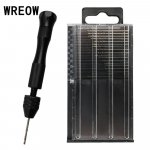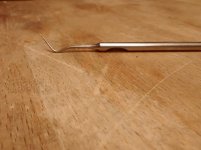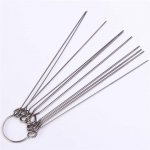I have faced the same issue. The problem is the heat does not get to the solder that is trapped within the thickness of the board. For boards that are not too thick, let's say 2mm or less, you can use some of the needle style soldering tips. Push them through and further open the hole with a needle. Hopefully, you have a soldering iron of sufficient quality that it has replaceable tips. But when working with 3mm+ boards, even these do not work as they cannot apply heat to the trapped solder. For these cases, I have successfully used mini drills such as in the attached photo. These I have obtained from AliExpress for less than $5US. A set that includes .3mm is essential. And many extra drill bits, as they are of low quality and tend to bend. Start small and work your way up in diameter. One key is to not waste too much time using braid and solder suckers, they are ineffective and you end up overusing them and applying too much heat in an effort to reach the unreachable solder and damaging the board. Been there.
Attachments
Drills can work with simple, single-sided old skool boards I have found, but am hesitant about using them on more compact, and complex, multi-layer boards.
Mixing solder that has all been sucked out, and is in the trash really hasn’t been an issue. Using the lower temp solder has been the most reliable I have found, albeit tedious at times.
Mixing solder that has all been sucked out, and is in the trash really hasn’t been an issue. Using the lower temp solder has been the most reliable I have found, albeit tedious at times.
What gun do you use?
A cheapie from eBay. I know they cause some people trouble but it works fine for me. I've done thousands of holes over the years and if you follow a few simple rules it won't clog.
Sold under various names, with consumables readily available.
Attachments
Or something like this: https://www.weidinger.eu/img/600/744/resize/w/e/weller-t0053256699-014-wdd_81v_t0053256699.jpg
And only for clean the hole I use this: https://upload.wikimedia.org/wikipe...Holzzahnstocher.jpg/220px-Holzzahnstocher.jpg
And only for clean the hole I use this: https://upload.wikimedia.org/wikipe...Holzzahnstocher.jpg/220px-Holzzahnstocher.jpg
Last edited:
Thanks for this. Best practical advice I've seen in a long time. Now to find an ugly plaque removing thingy...There is a simple way to desolder the innards of the tht-holes: Use some pin made of a material that rejects solder, for instance V2A. I use that ugly thingy my dentist uses to remove plaque. Heat the via from the component side, set the pin just onto the solder blob. heat is as well. When hot enough, press on it and it will slip into the hole and press all the solder out of the hole. Remove soldering iron, wait a short moment. Now you can remove the pin that does not stick to solder, your via is open now😉
I use solder braid as well, but avoid if I can because it produces ugly sticking remnants of burned flux that are hard to remove.
First World members use and suggest modern fluxes easily available overnight from well known suppliers.What kind of flux do you use? How do you apply the extra to the braid?
Here in "emerging Nations" 🙄 we often DIY a lot 😀
Not using much solder wick, hand pumps are usually enough, or the odd "melting and slapping" against the table, but IF needed, I make my own out of speaker braid (I have whole rolls of it) and homemade flux: a half full jam bottle with alcohol (we can freely buy 94° ethylic) and a couple rosin "ice cubes" dissolved in.
I submerge speaker braid there and let excess drip back in the bottle.
Works like a charm.
I suggest you make some of that "universal flux" which is useful everywhere and "refresh" the flux coating on commercial solder wick when needed.
I also use that flux on my homemade PCBs to protect copper from oxidation and help future soldering.
You can also brush it on "difficult" places, for example I slightly scratch a pot back and apply a little before soldering a wire there.
Thanks for this. Best practical advice I've seen in a long time. Now to find an ugly plaque removing thingy...
They are called "desoldering needles" and many eBay sellers offer them for ridiculously low prices. Here is one example of many, many possibilities.
They're made of stainless steel, a material that electronics solder doesn't adhere to. Explanation plus video here
I recommend buying three or four sets, because the smallest-diameter needle (blue @ far left) gets bent pretty easily, and that's the one you'll be using 85% of the time.

Go to a shop that sells sewing supplies, those prices are wonderful, I got 25 crewels for 18 Rupees!
Crewel is a regular hand stitching needle.
Look up Needle Industries / Pony in India.
Practically, 0.6 / 0.8 / 1.0 / 1.2 are the drill sizes, so get needles like that, thin needles can break. Thick ones with long tapered tips are better.
Stainless wire will work too, finding small pieces is left to you...
Crewel is a regular hand stitching needle.
Look up Needle Industries / Pony in India.
Practically, 0.6 / 0.8 / 1.0 / 1.2 are the drill sizes, so get needles like that, thin needles can break. Thick ones with long tapered tips are better.
Stainless wire will work too, finding small pieces is left to you...
Thanks Naresh - sewing needles - did not think about this.Go to a shop that sells sewing supplies
I don't have to go too far, but my wife might not be so happy 😀
The Hakko FR-301 is not cheap, but it's fantastic with multilayer PCBs that have a lot of copper. It provides plenty of heat even at the lowest temperature setting, and it's easy to clean. No shop air required either. Drills and mechanical tools to force solid solder out of a joint scare the daylights out of me - just melt the solder and remove it when it is liquid or you might as well toss out the PCB.
Desoldering braid can work, but you have to be very careful not to grind the braid into the PCB and loosen the sometimes dodgy adhesive that holds the copper to the laminate. You'll have to practice a bit and destroy something you don't care about to get good at it.
The Hakko is a bit more sure-fire, even for a novice. Sometimes, it works best to add more solder to the existing joint to break up the oxides and provide enough solder to contact the Hakko tip completely, so that all of it can be removed. Again, practice makes perfect, but it's hard to destroy a PCB with the Hakko if you set the temperature sensibly.
https://www.tequipment.net/Hakko/FR-301/Desoldering-Equipment/Rework-Stations/
Desoldering braid can work, but you have to be very careful not to grind the braid into the PCB and loosen the sometimes dodgy adhesive that holds the copper to the laminate. You'll have to practice a bit and destroy something you don't care about to get good at it.
The Hakko is a bit more sure-fire, even for a novice. Sometimes, it works best to add more solder to the existing joint to break up the oxides and provide enough solder to contact the Hakko tip completely, so that all of it can be removed. Again, practice makes perfect, but it's hard to destroy a PCB with the Hakko if you set the temperature sensibly.
https://www.tequipment.net/Hakko/FR-301/Desoldering-Equipment/Rework-Stations/
I’ve seen that Hakko before, but was put off by the price. It does seem like to Right Tool For The Job though. Maybe it’s time I spend the money. Thanks for suggesting it.
Hakko FR-301 is awesome!
I cannot say enough great things about the Hakko FR-301.
I will admit, I struggled (a bit) with the cost... But not
near as much as the prior years of struggle, with
every other de-soldering solution...
My only regret, why did I delay the purchase??
I cannot say enough great things about the Hakko FR-301.
I will admit, I struggled (a bit) with the cost... But not
near as much as the prior years of struggle, with
every other de-soldering solution...
My only regret, why did I delay the purchase??
Agreed when the desolderer doesn't work.Heating and immediately smacking the board sharply on the bench can work surprisingly well.
You may need to add some solder first. Give that a try.
Sometimes whichever sucker tool you use, I stand the PCB up and desolder sideways, as gravity is not your friend with those pesky unsolderable holes.
Sorry for the thread revival but I'm going to ask the heretical question - are there any recommendations for lead free flux that's cleanable for higher frequency work?
I'm using MG Chemicals lead free solder (part 4900) which is good and has RA flux within it. In the past I've used RA flux out of a tub but I'm looking a couple of options - and it needs to be cleanable:
I'm leaning towards the second option as I want to remove the RA flux from the solder itself.
This is for DIY tube amps rather than mission critical.
I'm using MG Chemicals lead free solder (part 4900) which is good and has RA flux within it. In the past I've used RA flux out of a tub but I'm looking a couple of options - and it needs to be cleanable:
- flux pen - a zero clean but can be removed with a second cleaner pen.
- MG Chem's RA flux - then use an isopropyl alcohol to remove on a cotton bud.
I'm leaning towards the second option as I want to remove the RA flux from the solder itself.
This is for DIY tube amps rather than mission critical.
I use a desoldering gun ZD-8915
Works great, it sucks all the solder out of the through-holes, so that I simply can pull the components.

Works great, it sucks all the solder out of the through-holes, so that I simply can pull the components.
- Home
- Design & Build
- Construction Tips
- Having trouble completely removing solder from through-hole joints



